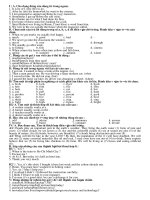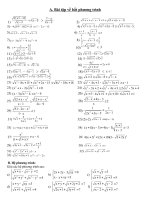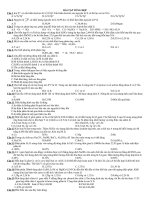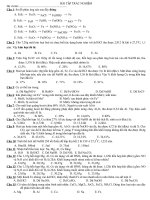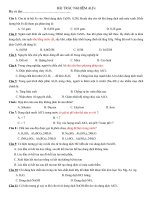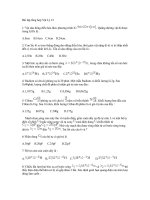Bài Tập tổng hợp C1
Bạn đang xem bản rút gọn của tài liệu. Xem và tải ngay bản đầy đủ của tài liệu tại đây (395.54 KB, 9 trang )
<span class='text_page_counter'>(1)</span><div class='page_container' data-page=1>
To address the source of infection in humans and
pub-lic health importance of <i>Giardia duodenalis </i>parasites from
animals, nucleotide sequences of the triosephosphate
iso-merase (TPI) gene were generated for 37 human isolates,
15 dog isolates, 8 muskrat isolates, 7 isolates each from
cattle and beavers, and 1 isolate each from a rat and a
rab-bit. Distinct genotypes were found in humans, cattle,
beavers, dogs, muskrats, and rats. TPI and small subunit
ribosomal RNA (SSU rRNA) gene sequences of <i>G. microti</i>
from muskrats were also generated and analyzed.
Phylogenetic analysis on the TPI sequences confirmed the
formation of distinct groups. Nevertheless, a major group
(assemblage B) contained most of the human and muskrat
isolates, all beaver isolates, and the rabbit isolate. These
data confirm that <i>G. duodenalis</i> from certain animals can
potentially infect humans and should be useful in the
detec-tion, differentiadetec-tion, and taxonomy of <i>Giardia</i>spp.
G
iardiasis is a common cause of diarrheal disease inalmost all vertebrates, including humans. In
industri-alized countries, it is referred to as a reemerging infectious
disease because of its increasingly recognized role in
out-breaks of diarrheal disease in daycare centers and in
water-and foodborne outbreaks. <i>Giardia</i>is also one of the most
frequently observed parasites infecting dairy cattle and
domestic dogs. In developing countries in Asia, Africa, and
Latin America, approximately 200 million people have
symptomatic giardiasis (1).
The taxonomy of <i>Giardia</i>at the species level is
compli-cated and unresolved because of limited morphologic
dif-ferences. Based on morphology, six species of this genus
are considered valid: <i>Giardia duodenalis</i>(syn. <i>G. lamblia</i>
or <i>G. intestinalis</i>) in a wide range of mammals, including
humans, livestock, and companion animals; <i>G. agilis</i> in
amphibians; <i>G. muris</i>in rodents; <i>G. ardeae</i>and <i>G. psittaci</i>
in birds; and <i>G. microti</i> in muskrats and voles (2–6).
However, on the basis of host origins, 41 <i>Giardia</i>species
have been named (7,8).
Molecular tools have been used recently to characterize
the epidemiology of human giardiasis. Although isolates of
<i>G. duodenalis</i>from humans and various animals are
mor-phologically similar, distinct host-adapted genotypes have
been demonstrated within <i>G. duodenalis</i> (1,9–12). Two
major groups of <i>G. duodenalis</i> have been recognized as
infecting humans worldwide, but there are some
differ-ences in naming of these groups, as evidenced by the
fol-lowing categorizations: Polish and Belgian genotypes (9);
groups 1, 2, and 3 (10,13); and assemblages A and B (11).
So far, no general consensus has been reached concerning
the nomenclature of these genotypes, but the term
assem-blages has been more widely used. The finding of
host-adapted <i>Giardia</i>genotypes is of public health importance,
considering the controversy regarding the zoonotic
poten-tial of <i>Giardia</i>(1,14).
We describe the development of a two-step nested
poly-merase chain reaction (PCR) protocol to amplify the
triosephosphate isomerase (TPI) gene of <i>G. duodenalis</i>and
<i>G. microti</i> and nucleotide sequence characterization of
amplified TPI fragment. The TPI gene was chosen because
of the high genetic heterogeneity displayed by <i>Giardia</i>
spp. at this locus (12,15). Results of the study have
validat-ed previous observations on the genetic diversity of
<i>Giardia</i> parasites on the basis of characterization of the
glutamate dehydrogenase (GDH), small subunit ribosomal
RNA (SSU rRNA), and TPI genes (12,15–17). These data
also suggest that some animal isolates of <i>G. duodenalis</i>are
Triosephosphate Isomerase Gene
Characterization and Potential
Zoonotic Transmission of
<i>Giardia duodenalis </i>
<b>Irshad M. Sulaiman,* Ronald Fayer,† Caryn Bern,* Robert H. Gilman,‡ James M. Trout,† </b>
<b>Peter M. Schantz,* Pradeep Das,§ Altaf A. Lal,* and Lihua Xiao*</b>
</div>
<span class='text_page_counter'>(2)</span><div class='page_container' data-page=2>
of zoonotic potential. These data should be useful in
devel-oping alternative molecular tools to differentiate <i>Giardia</i>
parasites at species and genotype levels and in
investigat-ing giardiasis outbreaks or endemic diseases.
<b>Materials and Methods</b>
<i><b>G. duodenalis</b></i><b>Isolates and DNA Extraction </b>
Fecal samples containing <i>G. duodenalis </i>cysts were
obtained from infected humans, cattle, companion animals
(dogs and a rabbit), aquatic wildlife (beavers and
muskrats), and one rat. Human samples were mostly from
sporadic cases, with the exception of two isolates (4599,
4600) from a foodborne outbreak. Fecal samples with <i>G.</i>
<i>microti </i>were obtained from infected muskrats. <i>Giardia</i>
infection was diagnosed by microscopy of wet mounts or
immunofluorescence-stained materials. Samples were
stored at 4°C in 2.5% (w/v) potassium dichromate solution
or frozen at –20°C and used in DNA extraction without
cyst isolation (Table 1). For DNA extraction, 200 µL of the
fecal suspension from each sample was aliquoted and
washed three times with distilled water. The material was
treated initially with 66.7 µL of 1 M KOH and 18.6 µL of
1 M dithiothreitol (DTT) followed by neutralization with
8.6 µL of 25% (v/v) hydrochloric acid. The DNA lysate
was then extracted once with phenol:chloroform:isoamyl
alcohol (25:24:1) solution, and purified by using the
QIAamp DNA Stool Kit (QIAGEN Inc, Valencia, CA).
Because the extracted DNA contained nucleic acids from
both <i>Giardia </i>cysts and fecal materials, DNA concentration
was not determined for all samples.
<b>PCR Amplification of the TPI Gene </b>
To amplify the TPI fragment from various <i>Giardia</i>
iso-lates, a nested PCR protocol was developed that used
primers complementary to the conserved published TPI
nucleotide sequences of various <i>Giardia</i> parasites
down-loaded from GenBank: <i>G. duodenalis</i>(U57897, AF06957
to AF069563, L02116, L02120), <i>G. muris</i> (AF069565),
and <i>G. ardeae</i>(AF069564). For the primary PCR, a PCR
product of 605 bp was amplified by using primers
AL3543 [5′-AAATIATGCCTGCTCGTCG-3′] and
AL3546 [5′-CAAACCTTITCCGCAAACC-3′]. The PCR
reaction comprised 0.25–2.0 µL of DNA, 200 µM each of
deoxynucleoside triphosphate (dNTP), 1X PCR buffer
(Perkin Elmer, Wellesley, MA), 3.0 mM MgCl2, 5.0 U of
<i>Taq</i>polymerase (GIBCO BRL, Frederick, MD), and 200
nM of each primer in a total of 100-µL reaction. The
reac-tions were performed for 35 cycles (94°C for 45 s, 50°C
for 45 s, and 72°C for 60 s) in a Perkin-Elmer GeneAmp
PCR 9700 thermocycler, with an initial hot start (94°C for
5 min) and a final extension (72°C for 10 min). For the
secondary PCR, a fragment of 530 bp was amplified by
using 2.5 µL of primary PCR reaction and primers
AL3544 [5′-CCCTTCATCGGIGGTAACTT-3′] and
AL3545 [5′-GTGGCCACCACICCCGTGCC-3′]. The
conditions for the secondary PCR were identical to the
primary PCR. The PCR products were analyzed by
agarose gel electrophoresis and visualized after ethidium
bromide staining.
<b>PCR Amplification of the SSU rRNA Gene </b>
A nested PCR protocol was also developed to amplify
the SSU rRNA fragment from <i>Giardia</i> isolates, using
primers complementary to the conserved published SSU
rRNA nucleotide sequences from various <i>Giardia</i>parasites
downloaded from GenBank: <i>G. duodenalis</i> (AJ278959,
AJ293295 to AJ293299, AJ293300, AJ293301, L29129,
M54878, U09491, U09492, X52949), <i>G. microti</i>
(AF006676, AF006677)<i>, G. muris</i> (X65063), and <i>G.</i>
<i>ardeae</i>(Z17210). For the primary PCR, a PCR product of
300 bp was amplified by using primers AL4303 [5′
-ATC-CGGTCGATCCTGCCG-3′] and reverse AL4305 [5′
-AGGATCAGGGTTCGACT-3′]. The PCR reaction was
performed by using the GC-RICH PCR System kit, which
consisted of GC-RICH Enzyme mix (Taq polymerase in
combination with a proofreading polymerase),
GC-RICH-PCR reaction buffer (includes a final 1.5 mM MgCl2 and
dimethyl sulfoxide [DMSO]), and GC-RICH resolution
solution (Roche Diagnostics, Indianapolis, IN) with
0.25–2.0 µL of DNA, 200 µM each of dNTP, and 200 nM
of each primer in a total of 50-µL reaction. For the
second-ary PCR, a fragment of 255 bp was amplified with the
GC-RICH PCR System kit (Roche) with 2.5 µL of primary
PCR reaction, and 200 nM of primers AL4304 [5′
-CGGTCGATCCTGCCGGA-3′] and AL4306 [5′
-GGCG-GAGGATCAGGGT-3′]. The cycling conditions for both
SSU RNA primary and secondary PCR were identical to
those used to amplify the TPI gene.
<b>DNA Sequencing and Phylogenetic Analysis</b>
</div>
<span class='text_page_counter'>(3)</span><div class='page_container' data-page=3>
Table 1. <i>Giardia</i> isolates with genotype identity
</div>
<span class='text_page_counter'>(4)</span><div class='page_container' data-page=4>
were aligned with TPI sequences of <i>Giardia </i>parasites
obtained in this study.
A neighbor-joining tree (19) was constructed on the
basis of the evolutionary distances calculated by the
Kimura-2-parameter model using the TreeconW program
(20). A sequence of <i>G. ardeae </i>(GenBank accession no.
AF069564) was used as the outgroup since the
construc-tion of an unrooted tree showed it to be the most divergent
member under analysis. The reliability of these trees was
assessed by using the bootstrap method (21) with 1,000
pseudoreplicates; values >70% were reported (22).
Nucleotide sequences of the TPI gene of <i>G. duodenalis</i>
from humans, cattle, dogs, muskrat, rat, and rabbit,
repre-senting different genotypes, were deposited in GenBank
under accession numbers AY228628 to AY228649.
A similar phylogenetic analysis was carried out on the
nucleotide sequences of the SSU rRNA gene from <i>G.</i>
<i>microti </i>in muskrats. SSU rRNA nucleotide sequences were
deposited in GenBank under accession numbers
AY228332 and AY228333.
<b>Results </b>
PCR products of the expected size (approximately 500
bp) were generated from all 76 isolates. All were
sequenced, and all of the nucleotide sequences obtained
belonged to the TPI sequences of <i>Giardia </i>based on
BLAST search of the GenBank database. The sources of
these isolates were humans (37 isolates), dogs (15
iso-lates), muskrats (8 isoiso-lates), cattle (7 isoiso-lates), beavers (7
isolates), rabbit (1 isolate) and rat (1 isolate). The TPI gene
of <i>Giardia</i>parasites was rich in GC content, ranging from
50.1% to 58.2% (Table 1). Isolates within each genotype,
however, had very similar GC contents in the TPI gene.
The extent of genetic diversity in the genus <i>Giardia</i>
was assessed by multiple alignments of the TPI nucleotide
sequences followed by estimates of genetic distances
(Table 2). The analysis showed distinct sequences for the
human, cattle, beaver, dog, muskrat, and rat isolates; most
animals had one genotype, and humans and muskrats had
two genotypes. The genetic polymorphism in <i>Giardia </i>
par-asites was evident along the entire TPI gene both at the
interspecies (<i>Giardia</i> spp.) and intraspecies (<i>G. </i>
<i>duode-nalis</i>) levels.
To understand the genetic structure of <i>Giardia </i>
para-sites, a neighbor-joining tree was constructed in a
phyloge-netic analysis of aligned TPI gene sequences of various
<i>Giardia </i>species and <i>G. duodenalis</i>genotypes; we used the
nucleotide sequence of <i>G. ardeae</i> (AF069564) as an
out-group to root the tree (Figure 1). The phylogenetic
analy-sis showed four distinct clusters for the genus <i>Giardia</i>. The
first cluster consisted of all isolates of <i>G. duodenalis </i>from
various sources (humans, cattle, cats, dogs, beavers,
muskrats, pigs, and rats). The second cluster consisted of
some of the isolates from muskrats. The third and fourth
cluster was each represented by a single published
sequence of <i>G. muris </i>(AF069565) and <i>G. ardeae</i>
(AF069564).
Several large groups were in the <i>G. duodenalis</i>cluster.
A major group (assemblage B) was formed with most of
the human and muskrat isolates, all the isolates from
beavers, and the rabbit isolate (Figure 1). The remaining
human isolates aligned with other previously reported
human TPI sequences and formed a distinct cluster
(assemblage A). Distinct clusters were also evident for the
Table 1 continued. <i>Giardia</i> isolates with genotype identity
</div>
<span class='text_page_counter'>(5)</span><div class='page_container' data-page=5>
isolates from dogs (assemblage C) and rats (undefined).
The cattle sequences, together with the published pig TPI
sequence, also formed a distinct cluster (assemblage E or
hoofed livestock genotype). Phylogenetic analysis
indicat-ed that assemblages B and C and the rat genotype were
related to each other and that assemblages A and E and the
cat genotype were related to each other. The formation of
all major groups was supported by bootstrap analysis with
full statistical reliability (Figure 1).
Intragenotypic variations were evident within
assem-blages A, B, C, and E (Table 3). A very high degree of
polymorphism was noticed within the isolates from
humans. The human isolates grouped in assemblage B had
five SNPs (single nucleotide polymorphisms): A or G at
position 39, C or T at position 91, G or A at position 162,
C or T at position 165, and C or T at position 168 (position
numbers according to the GenBank accession no. L02116).
Within assemblage B, 12 subtypes of <i>G. duodenalis</i>were
noticed; 11 of these had not been reported before (Figure
2). No genetic polymorphism was evident in the TPI
sequences of the beaver isolates characterized so far,
which were identical to those from most muskrats
belong-ing to the major assemblage B group. However, two
muskrat isolates (3565, 3569) in assemblage B had one
SNP at position 216 (C to T). Six SNPs (A or G at position
51, T or C at position 77, T or G at position 150, C or T at
position 330, T or C at position 383, and C or A at position
393) were evident within the dog isolates (assemblage C).
Multiple alignments of sequences from hoofed livestock
showed two distinct subtypes in cattle with four SNPs (T
or C at position 72, G or T at position 78, T or C at
posi-tion 93, and G or A at posiposi-tion 109). The sequence from the
rat matched with the TPI sequence from another suckling
mouse (GenBank accession no. AF069562) with one SNP
(G to A) at position 54. No genetic variation was observed
in the human TPI sequences of assemblage A generated in
this study, even though three sequences from GenBank
(AF069556, L02120, and U57897) had three SNPs.
Since TPI nucleotide sequences of three isolates from
muskrats were very different from known <i>G. duodenalis</i>
isolates or with <i>C. muris</i> or <i>C. ardeae</i> and since they
formed a distinct cluster, these isolates were characterized
at the SSU rRNA locus. The <i>Giardia </i>SSU rRNA sequences
obtained were aligned with the published sequences.
Analysis showed that these isolates were <i>G. microti</i>. Of the
three muskrat SSU rRNA sequences from this study, two
(isolates 3460 and 3464) were identical to a published SSU
rRNA sequence (AF006676) from muskrats (6). The third
sequence (isolate 3463) was unique and had three SNPs
compared with the other two muskrat isolates and
AF006676. Isolate 3463 was still considered to be a
Table 2. Evolutionary genetic distances between different <i>Giardia</i> species and <i>Giardia duodenalis</i> assemblages
<i>G. ardeae</i> <i>G. muris</i>
Undefined
cat
Assemblage
A
Assemblage
E
Undefined
rat
Assemblage
C
Assemblage
B <i>G. microti</i>
<i>G. ardeae</i> 0.00 19.25 43.08 45.31 52.46 46.85 46.49 50.41 32.28
<i>G. muris</i> 0.00 46.53 47.48 47.40 47.38 47.14 47.40 44.26
undefined cat 0.00 10.53 12.82 19.16 22.40 24.34 32.23
Assemblage A 0.00 12.85 17.31 19.14 22.31 30.73
Assemblage E 0.00 23.07 22.35 25.54 36.88
undefined Rat 0.00 16.57 20.49 32.03
Assemblage C 0.00 21.69 27.72
Assemblage B 0.00 34.77
<i>G. microti</i> 0.00
</div>
<span class='text_page_counter'>(6)</span><div class='page_container' data-page=6>
sequence of <i>G. microti</i> because another published <i>G.</i>
<i>microti</i> sequence (AF006677) was even more divergent
(Figure 3a). A similar pattern of genetic polymorphism
was evident in the TPI gene; the sequences from isolates
3460 and 3464 were identical to each other but had six
SNPs compared with isolate 3463. This finding suggests
that at least two distinct genotypes of <i>G. microti</i>were
pres-ent in muskrats (Figure 3b).
<b>Discussion</b>
Understanding the taxonomic relationship of a
particu-lar group of protozoan parasites that truly reflects
biologi-cal characteristics and evolutionary relationships is
diffi-cult. Most protozoan parasites lack fossil records, are
microscopic, and have few informative morphologic and
ultrastructural characters; some lack sexual reproduction
(23,24). Although <i>Giardia</i> spp. populate the intestinal
tracts of almost every group of vertebrates, <i>G. duodenalis</i>
is the only species found in humans and many other
mam-mals including cattle, cats, dogs, horses, sheep, and pigs
(1,25,26). <i>Giardia </i>cysts have also been detected in various
wild mammals (14,27–34). Although these wild mammals
are generally assumed to be infected with <i>G. duodenalis</i>,
molecular characterization to support this supposition is
lacking.
Even though <i>Giardia</i> isolates from different
mam-malian hosts were similar in form, a marked biological
diversity among these isolates was noticed in host
infectiv-ity (35), metabolism (36), and in vitro and in vivo growth
requirements (37,38). Multilocus enzyme electrophoresis
identified a number of distinct groups of <i>G. duodenalis</i>
(39,40). The forgoing heterogeneity suggests that <i>G. </i>
<i>duo-denalis</i> is a species-complex (39,41,42). Phylogenetic
characterization based on the nucleotide sequences of
GDH, elongation factor 1α (EF1α), TPI, and SSU rRNA
genes suggests the presence of five to seven lineages of <i>G.</i>
<i>duodenalis </i>(12,17,43,44). Among the loci analyzed, TPI
has the highest degree of polymorphism (12). However,
only four isolates from humans, two isolates from mice,
Table 3. Number of genotypes present in each assemblage
Assemblage No. of isolates studied No. of subtypes
A 6 1
B 44 12
C 15 4
E 7 2
Undefined rat 1 1
<i>Giardia microti</i> 3 2
</div>
<span class='text_page_counter'>(7)</span><div class='page_container' data-page=7>
and one isolate each from cat, dog, pig, rat (<i>G. muris), </i>and
blue heron (<i>G. ardeae</i>) have been characterized at the TPI
locus (12).
The genetic relationship among various <i>Giardia</i>
para-sites showed by phylogenetic analysis of the TPI gene in
this study is largely in agreement with previous
observa-tions based on results from the SSU rRNA, TPI, GDH, and
EF1αgenes (12,17,43,44). Thus, on the basis of published
and present TPI nucleotide sequences, the following
groupings of <i>G. duodenalis</i> parasites are evident by all
analyses with strong statistical reliability: 1) the formation
of a group containing relatively few human isolates
(assemblage A); 2) a major group containing most of the
human and muskrats isolates, as well as isolates from
beavers and a rabbit (assemblage B); 3) the formation of a
group containing all isolates from cattle and pigs
(assem-blage E or the hoofed livestock genotype); 4) the formation
of a group containing isolates from dogs (assemblage C);
5) an undefined cat genotype; and 6) an undefined
geno-type from rats. The assemblage D previously seen in a few
dogs (42) was not found in this study.
In our study, a distinct and more distant cluster was
formed by some isolates from muskrats. DNA sequence
analysis of the SSU rRNA gene indicated that these
iso-lates were <i>G. microti</i>. This organism was placed between
the clades representing the <i>G. muris</i>and all the six
assem-blages of <i>G. duodenalis</i>. <i>Giardia microti</i>was established as
a separate species because of sequence uniqueness of the
SSU rRNA gene and minor morphologic differences from
<i>G. duodenalis</i>(5,6). Our characterization of TPI nucleotide
sequences from muskrats supports the validity of <i>G.</i>
<i>microti</i>.
Results of phylogenetic analysis are useful in
under-standing the public health importance of some <i>G. </i>
<i>duode-nalis</i>parasites. Human <i>G. duodenalis</i>are placed in two
dis-tinct lineages (assemblages A and B), whereas the other
four lineages contain only <i>G. duodenalis</i> from animals
(assemblages C and E, and undefined cat and rat
geno-types). One of the assemblages in humans, assemblage B,
also contains all beaver isolates and some isolates from
muskrats, rabbits, and mice, which strongly suggests that
these animal isolates have the potential to infect humans.
<i>Giardia</i>from beavers has been suggested as the source of
infection for backpackers and some waterborne outbreaks
of giardiasis (27,30). Results of our study provide genetic
evidence to substantiate these claims.
The TPI-based genotyping tool is also useful in
epi-demiologic investigations of giardiasis in humans
(15,45,46). A recent study in the United Kingdom of
spo-radic cases of human giardiasis used a TPI-based
PCR–restriction fragment length polymorphism
genotyp-ing tool. Of the 33 TPI-PCR–positive infected patients, 21
(64%) were infected with assemblage B, 9 (27%) with
assemblage A, and 3 (9%) samples were mixed infections
of assemblages A and B (47). Similar results were obtained
with samples from a nursery outbreak, in which 21 (88%)
of 24 samples were shown to be <i>G. duodenlais</i>assemblage
B parasites; the rest were assemblage A parasites (47). The
intragenotypic variations of TPI in assemblage B identified
in the present study should be useful in subtyping outbreak
isolates. Because <i>Giardia</i> spp. have a clonal population
structure (40), the use of a typing system based on
sequence analysis of a single genetic locus with high
sequence heterogeneity, such as TPI, can provide a
resolu-tion as high as multilocus sequence typing.
The results of our study suggest that the TPI gene is a
good phylogenetic marker for analysis of the molecular
evolutionary and taxonomic relationship of <i>G. duodenalis</i>
parasites. The genetic relationship shown by phylogenetic
analysis of the TPI gene is largely in agreement with that
obtained at other genetic loci. Results of the molecular
analyses support the conclusion that <i>G. duodenalis</i> is a
species-complex, a finding that should be useful in the
revision of <i>Giardia </i> taxonomy and standardization of
<i>Giardia</i>nomenclatures. Results of this study also indicate
that <i>Giardia</i> parasites from beavers, muskrats, mice, and
rabbits represent a potential public health concern.
</div>
<span class='text_page_counter'>(8)</span><div class='page_container' data-page=8>
<b>Acknowledgments</b>
We thank Padma Vijyalakshmi and William Wong for
pro-viding specimens and Kristie Ludwig and Robert Palmer for
technical support.
Dr. Sulaiman is a guest researcher in the Division of
Parasitic Diseases, National Center for Infectious Diseases,
Centers for Disease Control and Prevention. His major interests
focus on the molecular epidemiology and phylogenetics of
proto-zoan parasites.
<b>References</b>
1. Thompson RCA, Hopkins RA, Homan WL. Nomenclature and
genet-ic groupings of <i>Giardia</i> infecting mammals. Parasitology Today
2000;16:210–8.
2. Filice FP. Studies on the cytology and life history of a <i>Giardia </i>from
the laboratory rat. University of California Publications in Zoology
1952;57:53–46.
3. Erlandsen SL, Bemrick WL. SEM evidences for a new species,
<i>Giardia psittaci</i>. J Parasitol 1987;73:623–9.
4. Erlandsen SL, Bemrick WJ, Wellis CL, Feely DE, Kundson L,
Cambell SR, et al. Axenic culture and characterization of <i>Giardia</i>
<i>ardeae</i> from the great blue heron (<i>Ardea herodias</i>). J Parasitol
1990;76:717–24.
5. Feely DE. Morphology of the cyst of <i>Giardia microti</i>by light and
electron microscopy. J Protozool 1988;35:52–4.
6. van Keulen H, Feely DE, Macechko T, Jarrol EL, Erlandsen SL. The
sequence of <i>Giardia</i> small subunit rRNA shows that voles and
muskrats are parasitized by a unique species, <i>Giardia microti</i>. J
Parasitol 1998;84:294–300.
7. Campbell SR, van Keulen H, Erlandsen SL, Senturia JB, Jarrol EL.
<i>Giardia</i>sp: Comparison of electrophoretic karyotypes. Exp Parasitol
1990;71:470–82.
8. van Keulen H, Gutell R, Gates M, Campbell S, Erlandsen SL, Jarrol
EL, et al. Unique phylogenetic position of Diplomonadida based on
the complete small subunit ribosomal RNA sequence of <i>Giardia</i>
<i>ardeae, Giardia muris, Giardia duodenalis</i>and <i>Hexamita</i>sp. FASEB
J 1993;7:223–31.
9. Homan WL, van Enckevort FHJ, Limper L, van Eys GJJM, Schoone
GJ, Kasprzak W, et al. Comparison of <i>Giardia</i>isolates from different
laboratories by isoenzyme analysis and recombinant DNA probes.
Parasitol Res 1992;78:316–23.
10. Nash TE, Mowatt MR. Identification and characterization of a
<i>Giardia lamblia</i>group-specific gene. Exp Parasitol 1992;75:369–78.
11. Maryhofer G, Andrews RH, Ey PL, Chilton NB. Division of <i>Giardia</i>
isolates from humans into two genetically distinct assemblages by
electrophoretic analysis of enzymes coded at 27 loci and comparison
with <i>Giardia muris</i>. Parasitology 1995;111:11–7.
12. Monis PT, Andrews RH, Mayrhofer G, Ey PL. Molecular systematics
of the parasitic protozoan <i>Giardia intestinalis</i>. Mol Biol Evol
1999;16:1135–44.
13. Nash TE, McCutchan T, Keister D, Dame JB, Conard JD, Gillin FD.
Restriction endonuclease analysis of DNA from 15 <i>Giardia</i>isolates
obtained from humans and animals. J Infect Dis 1985;152:64–73.
14. Thompson RCA. Giardiasis as a re-emerging infectious disease and
its zoonotic potential. Int J Parasitol 2000;30:1259–67.
15. Baruch AC, Isaac-Renton J, Adam RD. The molecular epidemiology
of <i>Giardia lamblia</i>: a sequence-based approach. J Infect Dis
1996;174:233–6.
16. Ey PL, Andrews RH, Maryhofer G. Differentiation of major
geno-types of <i>Giardia intestinalis</i>by polymerase chain reaction analysis of
a gene encoding a trophozoite surface antigen. Parasitology
1993;106:347–56.
17. Monis PT, Mayrhofer G, Andrews RH, Homan WL, Limper L, Ey PL.
Molecular genetic analysis of <i>Giardia intestinalis</i>isolates at the
glu-tamate dehydrogenase locus. Parasitology 1996;112:1–12.
18. Genetics Computer Group. Wisconsin Package Version 90. Madison
(WI): Genetics Computer Group; 1996.
19. Saitou N, Nei M. The neighbor-joining method: a new method for
reconstructing phylogenetic trees. Mol Biol Evol 1987;4:406–25.
20. van de Peer Y, Wachter R De. TREECON for Windows: a software
package for the construction and drawing of evolutionary trees for the
Microsoft Windows environment. Comput Appl Bios
1994;10:569–70.
21. Felsenstein J. Confidence limits on the phylogenies: an approach
using bootstrap. Evolution 1985;39:783–91.
22. Efron B, Halloran E, Holmes S. Bootstrap confidence levels for
phy-logentic trees. Proc Natl Acad Sci U S A 1996;93:13429–34.
23. Barta JR. Investigating phylogenetic relationships within the
Apicomplexa using sequence data: the search of homology. Methods
1997;13:81–8.
24. Monis PT. The importance of systematics in parasitological research.
Int J Parasitol 1999;29:381–8.
25. Xiao L. <i>Giardia</i> infection in farm animals. Parasitol Today
1994;10:436–8.
26. Olson ME, McAllister TA, Deselliers L, Morck DW, Cheng KJ, Buret
AG, et al. Effects of giardiasis on production in a domestic ruminant
(lamb) model. Am J Vet Res 1995;56:1470–4.
27. Wallis PM, Buchanan-Mappin JM, Faubert GM, Belosevic M.
Reservoirs of <i>Giardia </i>spp. in southwestern Alberta. J Wildl Dis
1984;20:279–83.
28. Pacha RE, Clark GW, Williams EA. Occurrence of <i>Campylobacter</i>
<i>jejuni</i>and <i>Giardia</i>species in muskrats (<i>Ondarta zibethica</i>). Appl
Environ Microbiol 1985;50:177–8.
29. Kirkpatrick CE, Benson CE. Presence of <i>Giardia</i>spp. and absence of
<i>Salmonella </i>spp. in New Jersey muskrats (<i>Ondarta zibethicus</i>). Appl
Environ Microbiol 1987;53:1790–2.
30. Monzingo DL, Hibler CP. Prevalence of <i>Giardia</i> sp. in a beaver
colony and the resulting environmental contamination. J Wildl Dis
1987;23:576–85.
31. Patton S, Rabinowitz AR. Parasites of wild felidae in Thiland: a
coprological survey. J Wildl Dis 1994;30:472–5.
32. Karanis P, Opiela K, Renoth S, Seith HM. Possible contamination of
surface waters with <i>Giardia</i>spp. through muskrats. Zentra Bakteriol
1996;284:302–6.
33. Nizeyi JB, Mwebe R, Nanteza A, Cranfield MR, Kalema GR,
Graczyk TK. <i>Cryptosporidium</i> sp. and <i>Giardia </i>sp. infectious in
mountain gorillas (<i>Gorilla gorilla</i> beringi) of the Bwindi
Impenetrable National Park, Uganda. J Parasitol 1999;85:1084–8.
34. Rickard LG, Siefker C, Boyle CR, Gentz EJ. The prevalence of
<i>Cryptosporidium </i>and <i>Giardia</i>spp. in fecal samples from free-ranging
white-tailed deer (<i>Odocoileus virginianus</i>) in the southeastern United
States. J Vet Diagn Invest 1999;11:65–72.
35. Visvesvara GS, Dickerson JW, Healy GR. Variable infectivity of
human-derived <i>Giardia lamblia</i> cysts for Mongolian gerbils
(<i>Meriones unguiculatus</i>). J Clin Microbiol 1988;26:837–41.
36. Hall ML, Costa ND, Thompson RCA, Lymbery AJ, Meloni BP,
Wales RG. Genetic variants of <i>Giardia duodenalis</i> differ in their
metabolism. Parasitol Res 1992;78:712–4.
37. Andrews RH, Chilton NB, Maryhofer G. Selection of specific
geno-types of <i>Giardia intestinalis</i> by growth in vitro and in vivo.
Parasitology 1992;105:375–86.
38. Binz N, Thompson RCA, Lymbery AJ, Hobbs RP. Comparative
stud-ies on the growth dynamics of two genetically distinct isolates of
<i>Giardia duodenalis</i>in vitro. Int J Parasitol 1992;22:195–202.
39. Andrews RH, Adams M, Boreham PFL, Maryhofer G, Meloni BP.
</div>
<span class='text_page_counter'>(9)</span><div class='page_container' data-page=9>
40. Meloni BP, Lymbery AJ, Thompson RCA. Genetic characterization
of isolates of <i>Giardia duodenalis</i> by enzyme electrophoresis:
Implication of reproductive biology population structure taxonomy
and epidemiology. J Parasitol 1995;81:368–83.
41. Ey PL, Mansouri M, Kulda J, Nohynkova E, Monis PT. Genetic
analysis of <i>Giardia</i>from hoofed farm animals reveals
artiodactyls-specific and potentially zoonotic genotypes. J Eukaryot Microbiol
1997;44:626–35.
42. Monis PT, Andrews RH, Mayrhofer G, Kulda J, Isaac-Renton JL, Ey
PL. Novel lineages of <i>Giardia intestinalis</i>identified by genetic
analy-sis of organisms isolated from dogs in Australia. Parasitology
1998;116:7–19.
43. van Keulen H, Campbell SR, Erlandsen SL, Jarrol L. Cloning and
restriction enzyme mapping of ribosomal DNA of <i>Giardia </i>
<i>duode-nalis, Giardia ardeae</i> and <i>Giardia muris</i>. Mol Biochem Parasitol
1991;46:275–84.
44. Mowatt MR, Weinbach EC, Howard TC, Nash TT. Complementation
of <i>Escherichia coli</i>glycolysis mutant by <i>Giardia lamblia</i>
triosephos-phate isomerase. Exp Parasitol 1994;78:85–92.
45. Lu S, Li J, Zhang Y, Wen J, Wang F. The intraspecific difference of
the triose phosphate isomerase (tim) gene from <i>Giardia lamblia</i>. Chin
Med J (Engl) 2002;115:763–6.
46. Lu S, Wen J, Li J, Wang F. 2002. DNA sequence analysis of the
triose-phosphate isomerase gene from isolates of <i>Giardia lamblia</i>.
Chin Med J (Engl) 2002;115:99–102.
47. Amar CFL, Dear PH, Pedraza-Diaz S, Looker N, Linnane E,
McLauchlin J. Sensitive PCR-restriction fragment length
polymor-phism assay for detection and genotyping of <i>Giardia duodenalis</i>in
human feces. J Clin Microbiol 2002;40:446–52.
Address for correspondence: Lihua Xiao, Division of Parasitic Diseases,
National Center for Infectious Diseases, Centers for Disease Control and
Prevention, Building 22, Mailstop F12, 4770 Buford Highway, Atlanta,
GA 30341-3717, USA; fax: (770) 488-4454; email:
</div>
<!--links-->

